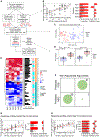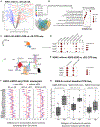Acute and persistent responses after H5N1 vaccination in humans
- PMID: 39235945
- PMCID: PMC11949244
- DOI: 10.1016/j.celrep.2024.114706
Acute and persistent responses after H5N1 vaccination in humans
Abstract
To gain insight into how an adjuvant impacts vaccination responses, we use systems immunology to study human H5N1 influenza vaccination with or without the adjuvant AS03, longitudinally assessing 14 time points including multiple time points within the first day after prime and boost. We develop an unsupervised computational framework to discover high-dimensional response patterns, which uncover adjuvant- and immunogenicity-associated early response dynamics, including some that differ post prime versus boost. With or without adjuvant, some vaccine-induced transcriptional patterns persist to at least 100 days after initial vaccination. Single-cell profiling of surface proteins, transcriptomes, and chromatin accessibility implicates transcription factors in the erythroblast-transformation-specific (ETS) family as shaping these long-lasting signatures, primarily in classical monocytes but also in CD8+ naive-like T cells. These cell-type-specific signatures are elevated at baseline in high-antibody responders in an independent vaccination cohort, suggesting that antigen-agnostic baseline immune states can be modulated by vaccine antigens alone to enhance future responses.
Keywords: CP: Immunology; CP: Microbiology; adjuvant; antigen-agnostic memory; baseline immune state; immune response dynamics; single cell analysis; systems immunology; trained immunity; vaccine.
Copyright © 2024 The Author(s). Published by Elsevier Inc. All rights reserved.
Conflict of interest statement
Declaration of interests R.G.v.d.M. is a former employee of and holds shares in the GSK group of companies. B.S. is a former SomaLogic, Inc. (Boulder, CO, USA), employee and a company shareholder. J.S.T. serves on the scientific advisory boards of CytoReason, Immunoscape, and the Human Immunome Project.
Figures




References
-
- Schijns VEJC (2003). Mechanisms of vaccine adjuvant activity: initiation and regulation of immune responses by vaccine adjuvants. Vaccine 21, 829–831. - PubMed
-
- Shi S, Zhu H, Xia X, Liang Z, Ma X, and Sun B (2019). Vaccine adjuvants: Understanding the structure and mechanism of adjuvanticity. Vaccine 37, 3167–3178. - PubMed
-
- Givord C, Welsby I, Detienne S, Thomas S, Assabban A, Lima Silva V, Molle C, Gineste R, Vermeersch M, Perez-Morga D, et al. (2018). Activation of the endoplasmic reticulum stress sensor IRE1α by the vaccine adjuvant AS03 contributes to its immunostimulatory properties. NPJ Vaccines 3, 20. - PMC - PubMed
Publication types
MeSH terms
Substances
Grants and funding
LinkOut - more resources
Full Text Sources
Other Literature Sources
Medical
Molecular Biology Databases
Research Materials
Miscellaneous

